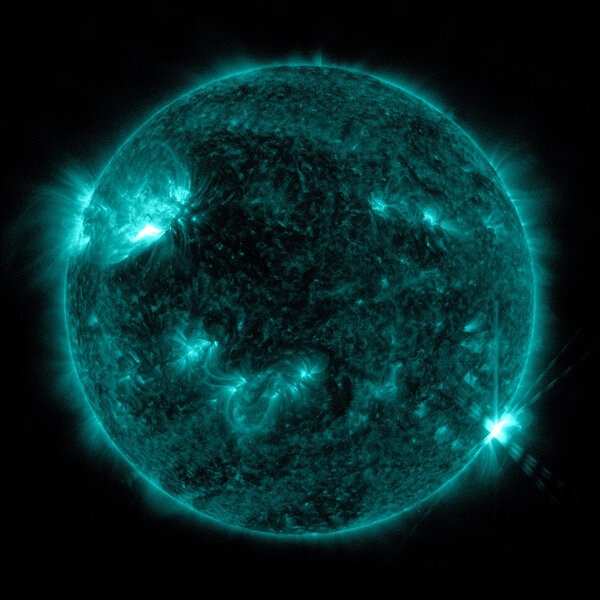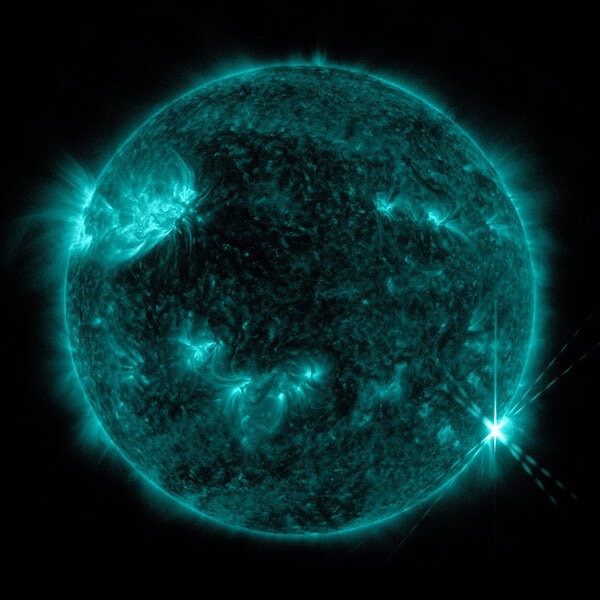Create a free profile to get unlimited access to exclusive videos, sweepstakes, and more!
The Earth just got hit with two powerful solar flares and more are on the way
The Sun is getting fiesty.

During humanity’s first crewed mission to Jupiter’s icy moon Europa, the spacecraft Europa One was struck by a solar storm, cutting off communications with Earth. The storm was the result of a coronal mass ejection (CME), the violent release of part of the Sun’s magnetic field and accompanying high-energy plasma. When the burst of stellar energy hit the ship, it overloaded communications systems and cut them off from any earthly support. Of course, all of this is a fiction imagined by the filmmakers behind Europa Report (streaming now on Peacock!).
THREAT LEVEL? THE SOLAR STORM OF 1859 AND BEYOND
While the mission was fictional, the potential danger of extreme solar activity is very real. CMEs and their less powerful siblings, solar flares, happen all the time. And they’ve sucker punched our planet more than once. In September of 1859, an intense solar storm struck the planet, destroying fledgling communications technologies. There were reports that telegraph lines were so energized that at least one telegraph office burst into flames. Certainly, modern society relies much more heavily on communications technologies, and a similar event today would likely be much more catastrophic.
RELATED: Zombie sunspot reanimated out of nowhere and went into full attack mode
On April 19, NASA announced that two powerful solar flares had erupted from the Sun, on a course toward Earth. The flares peaked at 9:35 p.m. and 11:57 p.m. ET, respectively, according to observations by NASA’s Solar Dynamics Observatory. These flares can last minutes or hours and impact everything from the electrical grid to radio communications and navigation signals. They pose a particular risk to any astronauts in orbit. Worse, because the damaging electromagnetic radiation travels at the speed of light, by the time we see a flare coming, it’s already here.
When flares hit the atmosphere, increased levels of X-ray and UV radiation ionize the lower levels of the ionosphere on the Sun-facing side of the planet. If a flare is powerful enough, it can punch into even lower levels of the ionosphere and interfere with radio waves carrying information. Signals transmitted during a storm could be degraded or lost entirely. That’s a problem if communication is a necessary component of your survival. While a solar flare won’t harm you directly, the downstream effects to the infrastructure of our civilizations could be significant.
HOW STRONG SOLAR FLARES ARE CLASSIFIED
The solar flare classification system takes a cue from other natural disaster measurement schemes, like the Richter Scales used for classifying earthquakes. Instead of using pure numbers, solar flares use a letter-number combo system which is, admittedly, not intuitive. Astronomers measure the peak emission in the soft X-ray part of the spectrum, between 0.1 and 0.8 nm. Peak emission in that band is what tells scientists how powerful a flare is. Flares can also be categorized by the amount of radiation striking the planet, measured in watts per square meter.
The weakest flares are classified as A-Class. A flare 10 times more powerful is B-Class. Another tenfold increase gets you to C-Class. Now, you might think you’ve picked up on the pattern here and the next class will be D, but that’s a common mistake. Flares 10 times more powerful than C-Class are M-Class, and 10 times more powerful than that are X-Class. They represent flares 10,000 times more powerful than A-Class flares.
You can further break down individual flares by adding a number. So, a flare a few times more powerful than a standard A-Class flare might get a classification of A4 or A5, all the way up to A9. The same is true of flares in the B, C, and M classes, but not X-Class flares. Their power is unbounded. Rather than slap another letter once you get 10 times more powerful than an X-Class, they just keep adding numbers.
A, B, and C-Class flares are typically too weak to noticeably impact the Earth, but M-Class flares can disrupt communications and X-Class flares can do all that and more. Solar activity has been recorded for roughly the last two and a half centuries, and the most powerful solar flare recorded in all that time was pretty recently, in 2003. Astronomers observing the Sun during that event recorded radiation levels as high as X28, but that’s when the instruments went on the fritz, suggesting that the flare was actually even more powerful. It’s sort of the cosmic equivalent of dipping a glass thermometer into lava and saying it’s at least 120 Fahrenheit, because that’s as high as the mercury rose before your thermometer exploded.
WHEN WAS THE LAST SOLAR STORM AND HOW CAN WE PREDICT THE NEXT?
On Earth, our magnetic field is generated by the motion of the planet’s liquid metal core. On the Sun, however, it’s liquid core all the way down, so to speak. What is mostly a massive ball of hydrogen roils and ripples under the competing forces of gravity and fusion, creating powerful magnetic fields unparalleled anywhere else in the solar system.
RELATED: The Sun blasted plasma 2.2 million miles into space in its most enormous eruption ever
That magnetic field is always changing, and, like a slowly winding coil, it is constantly moving toward the moment when everything snaps. For the Sun, that happens on a roughly 11-year cycle which ebbs and flows between periods of high and low solar activity. When we’re at a low point in the cycle, sunspots, solar radiation, and ejected material from CMEs and solar flares are at their minimum. At the other end of the cycle the opposite is true. Sunspots, solar flares, and CMEs increase in frequency until the Sun hits solar maximum. Then the magnetic field flips and things calm back down, before winding up again.
Right now, we’re headed toward solar maximum of solar cycle 25 (referencing the number of cycles since astronomers started tracking). The peak is expected to occur in July 2025. Consequently, we can expect an increase in solar flares and other solar activity over the next couple of years. The good news is, it’s unlikely that we’ll be hit by anything powerful enough to really mess things up. After all, we got hit by an M-Class and X-Class flare last night, and no one aside from a few incredibly dedicated scientists even noticed.
It’s easy to take the Earth’s protective barriers for granted when you’re not hurtling through space toward an icy moon. Catch Europa Report, streaming now on Peacock!




























